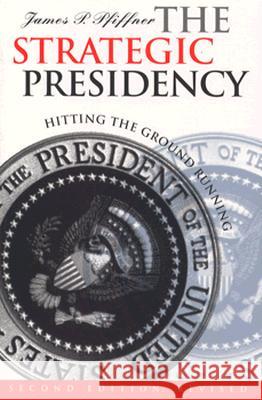The Strategic Presidency: Hitting the Ground Running?second Edition Revised » książka
topmenu
The Strategic Presidency: Hitting the Ground Running?second Edition Revised
ISBN-13: 9780700607693 / Angielski / Miękka / 1996 / 272 str.
The Strategic Presidency: Hitting the Ground Running?second Edition Revised
ISBN-13: 9780700607693 / Angielski / Miękka / 1996 / 272 str.
cena 116,78
(netto: 111,22 VAT: 5%)
Najniższa cena z 30 dni: 111,00
(netto: 111,22 VAT: 5%)
Najniższa cena z 30 dni: 111,00
Termin realizacji zamówienia:
ok. 30 dni roboczych
Bez gwarancji dostawy przed świętami
ok. 30 dni roboczych
Bez gwarancji dostawy przed świętami
Darmowa dostawa!
Perfectly timed to anticipate the possible election of a new president in 1996, the second edition of James Pfiffner's The Strategic Presidency provides the most complete and authoritative volume on presidential transitions from JFK to Bill Clinton. First published in 1988, it is now more valuable than ever with the addition of new chapters on the Bush and Clinton transitions and numerous other revisions that greatly update the volume.
When the book first appeared eight years ago, it was hailed by the American Political Science Review as an important new work following in "the path that Richard Neustadt long ago blazed in his classic book, Presidential Power." Immediately recognized for its contributions to scholarship, it also popularized a new phrase, "the strategic presidency," which has since become an essential part of the lexicon in presidential studies. As this book makes clear, to accomplish his policy objectives, a new president must always first get control of the government. Thus the White House must organize itself; establish a cabinet; recruit presidential appointees; confront the entrenched career bureaucracy; and formulate a legislative agenda. The supreme challenge of this transitional period, Pfiffner argues, is that all of this must be done in a very compressed time frame and under the extreme pressure of press scrutiny and unrealistically high public expectations. Even so, he also shows that systematic preparation during this period can maximize a president's opportunity at the beginning of a term. Contrary to much conventional advice, Pfiffner contends that a newly elected president's best opportunity for achieving policy goals is at the beginning of the term. Even if a "honeymoon" atmosphere does not prevail, Congress is likely to be more receptive to presidential initiatives in the early months of a term, and public opinion is likely to decline after several months in office. That's why it's so important for presidents to "hit the ground running." Like the first edition, the new one provides a concise guide for scholars and presidential aides and will be widely adopted for courses on the modern presidency. With its fine blend of insider perspective, illuminating anecdotes, and user-friendly political analysis, it will also appeal to general readers.










